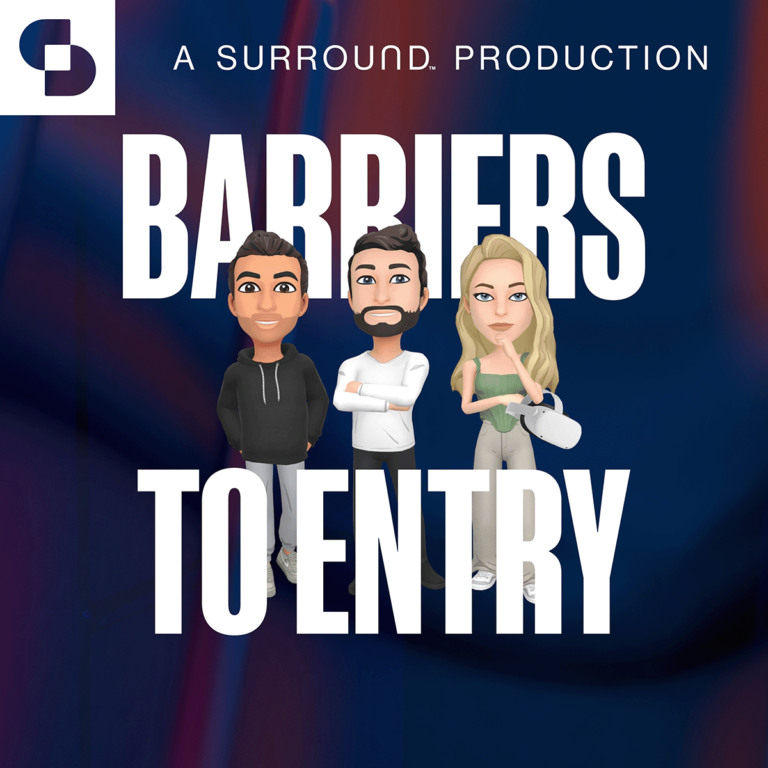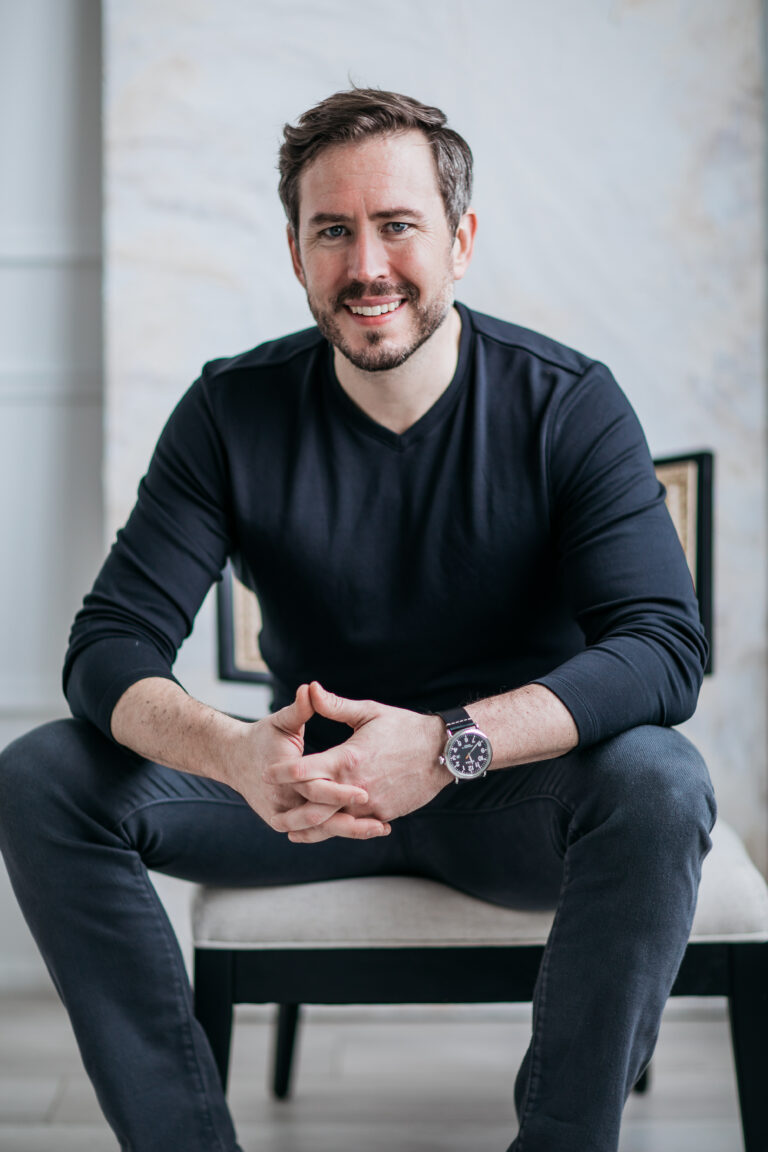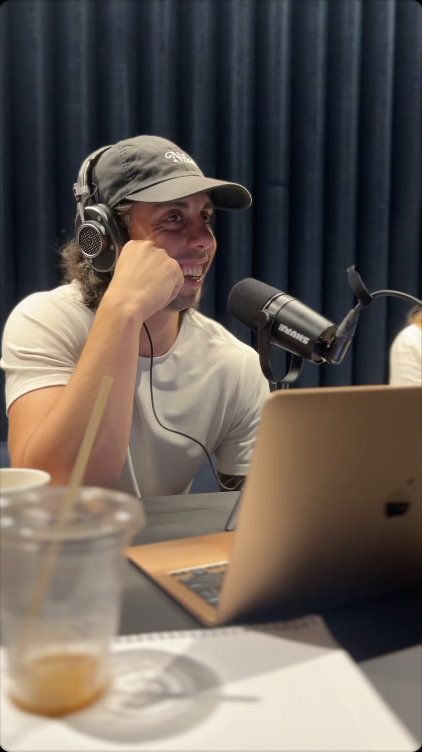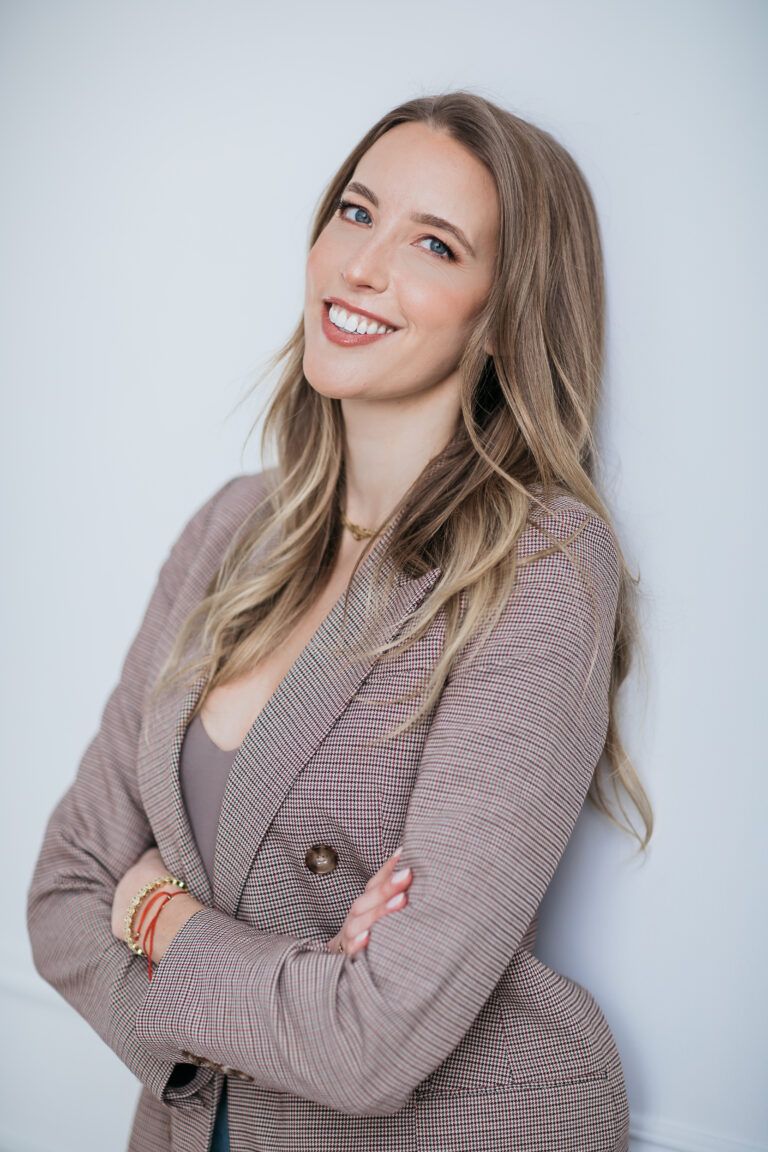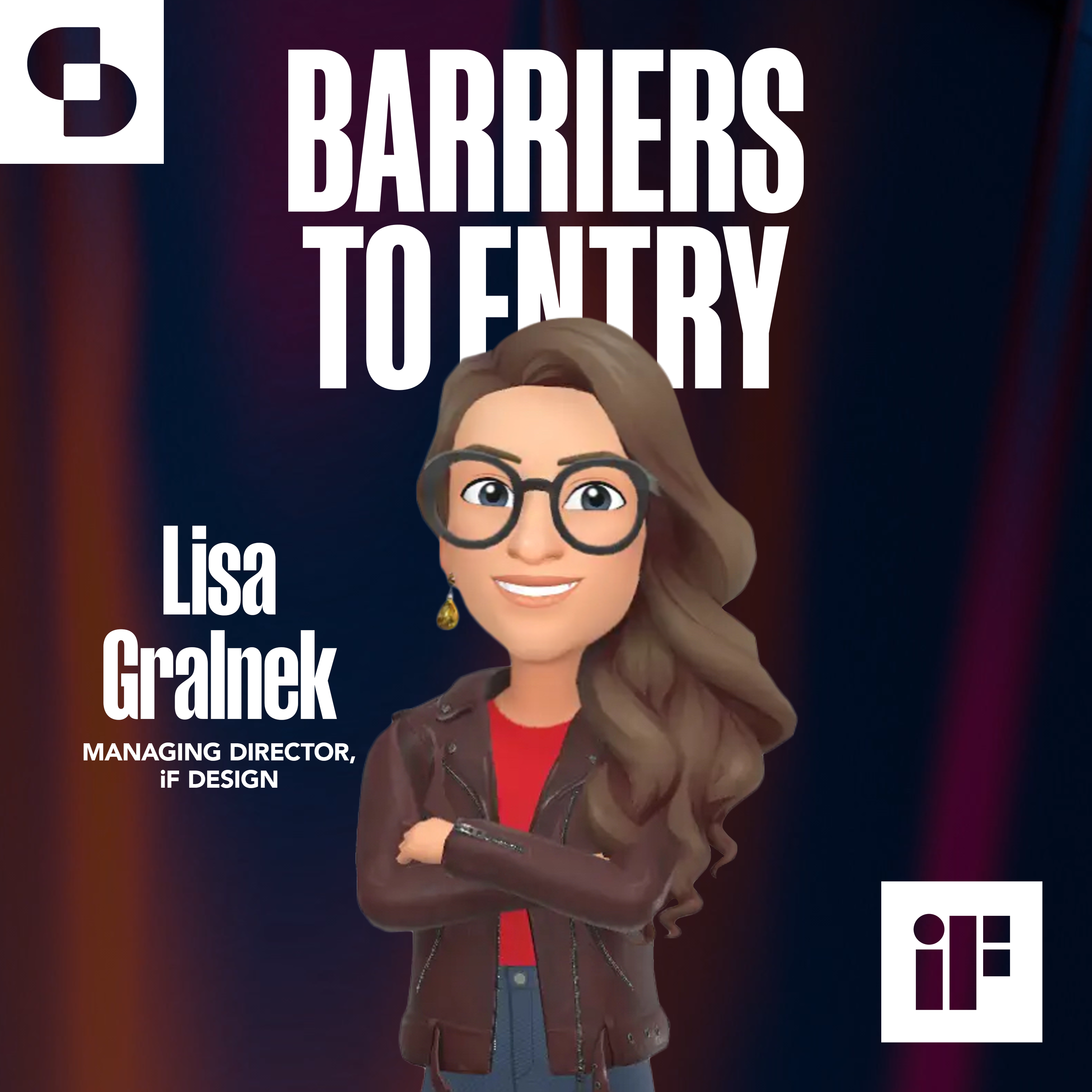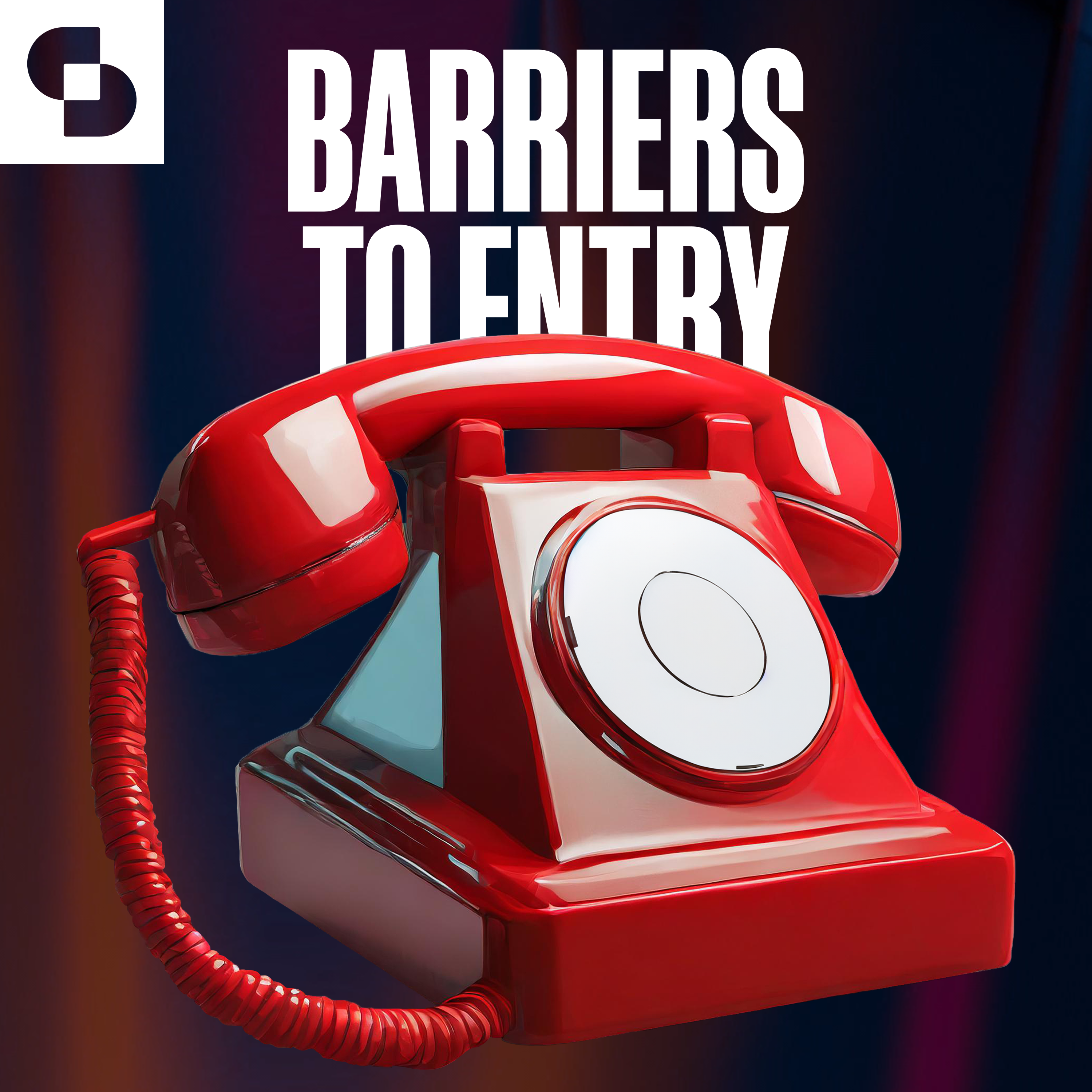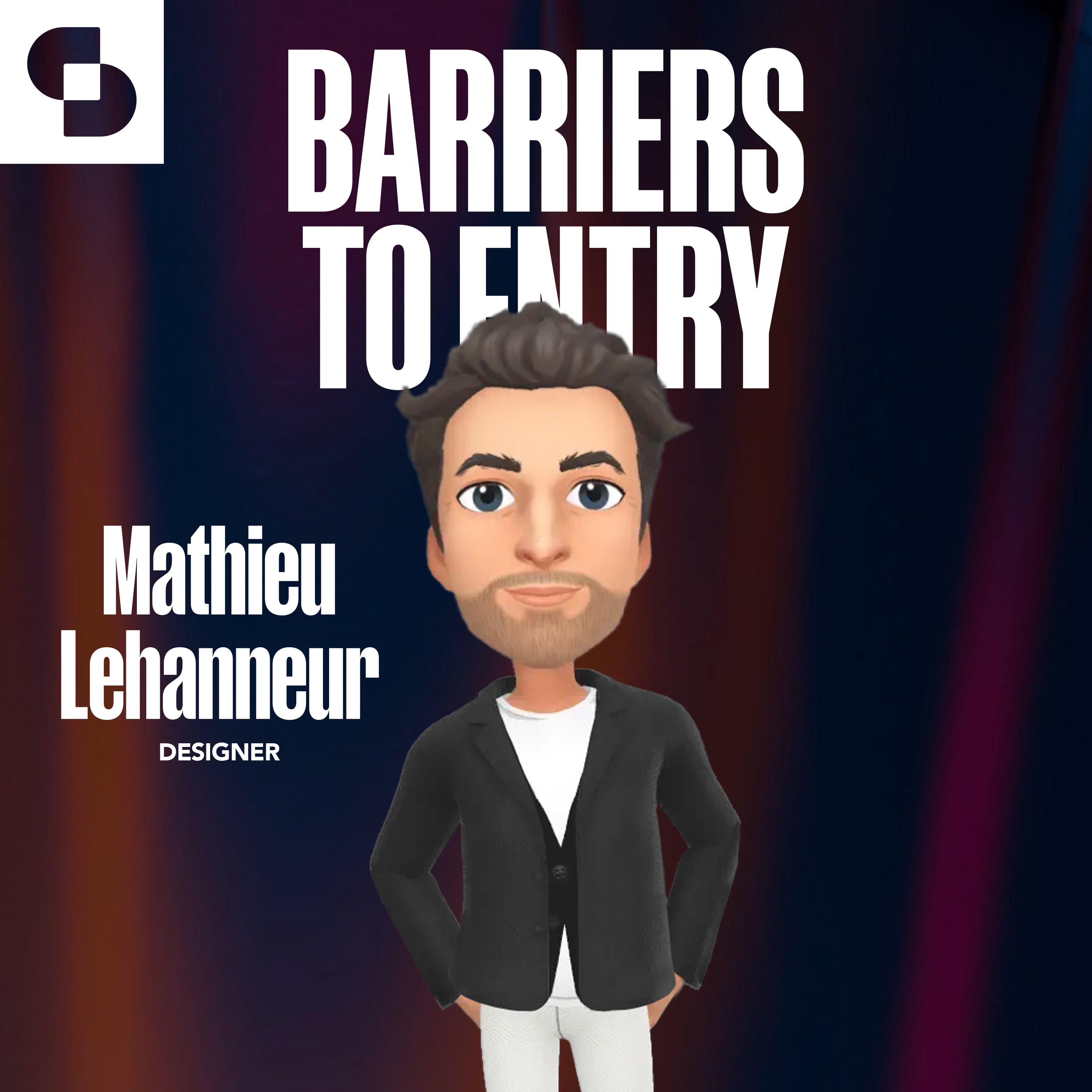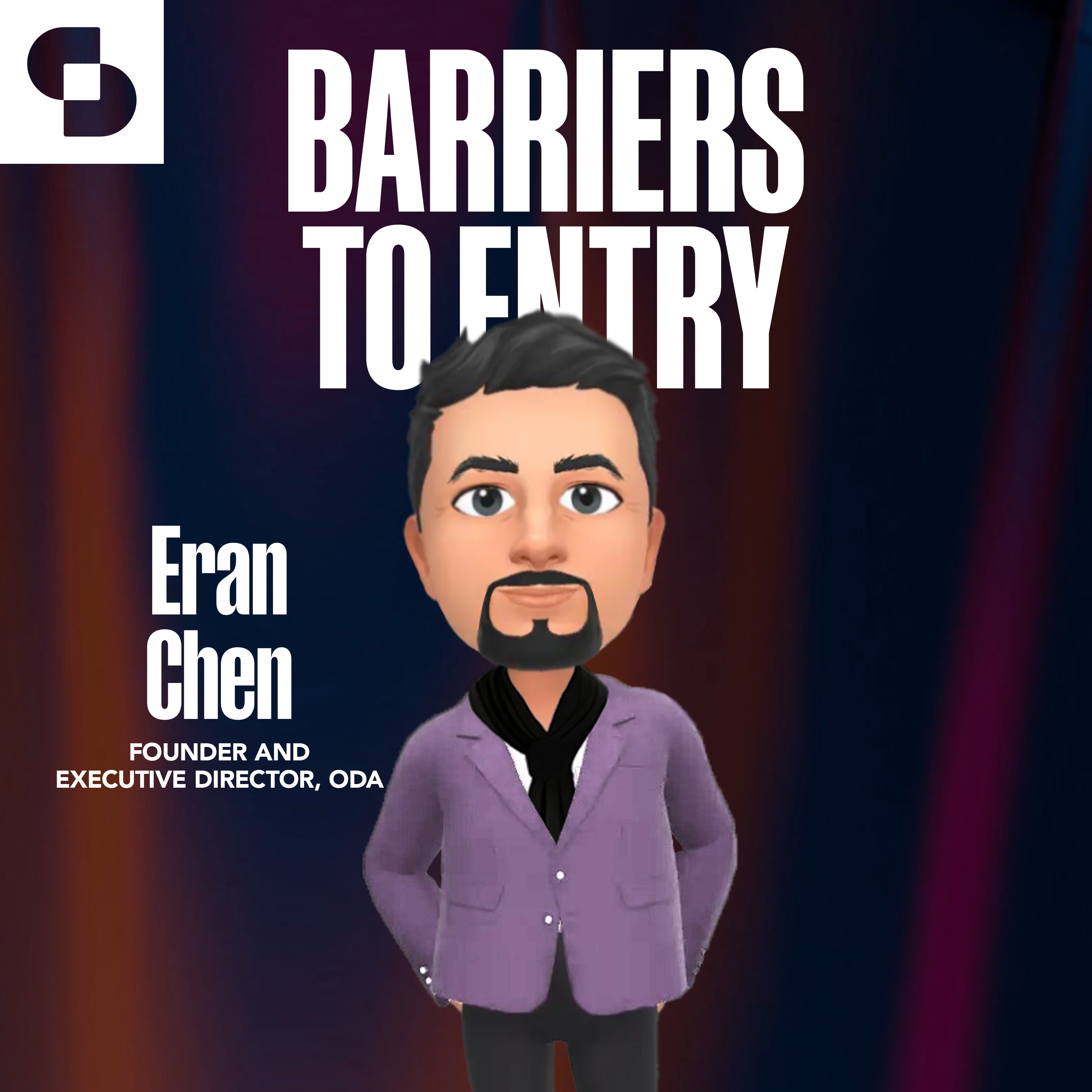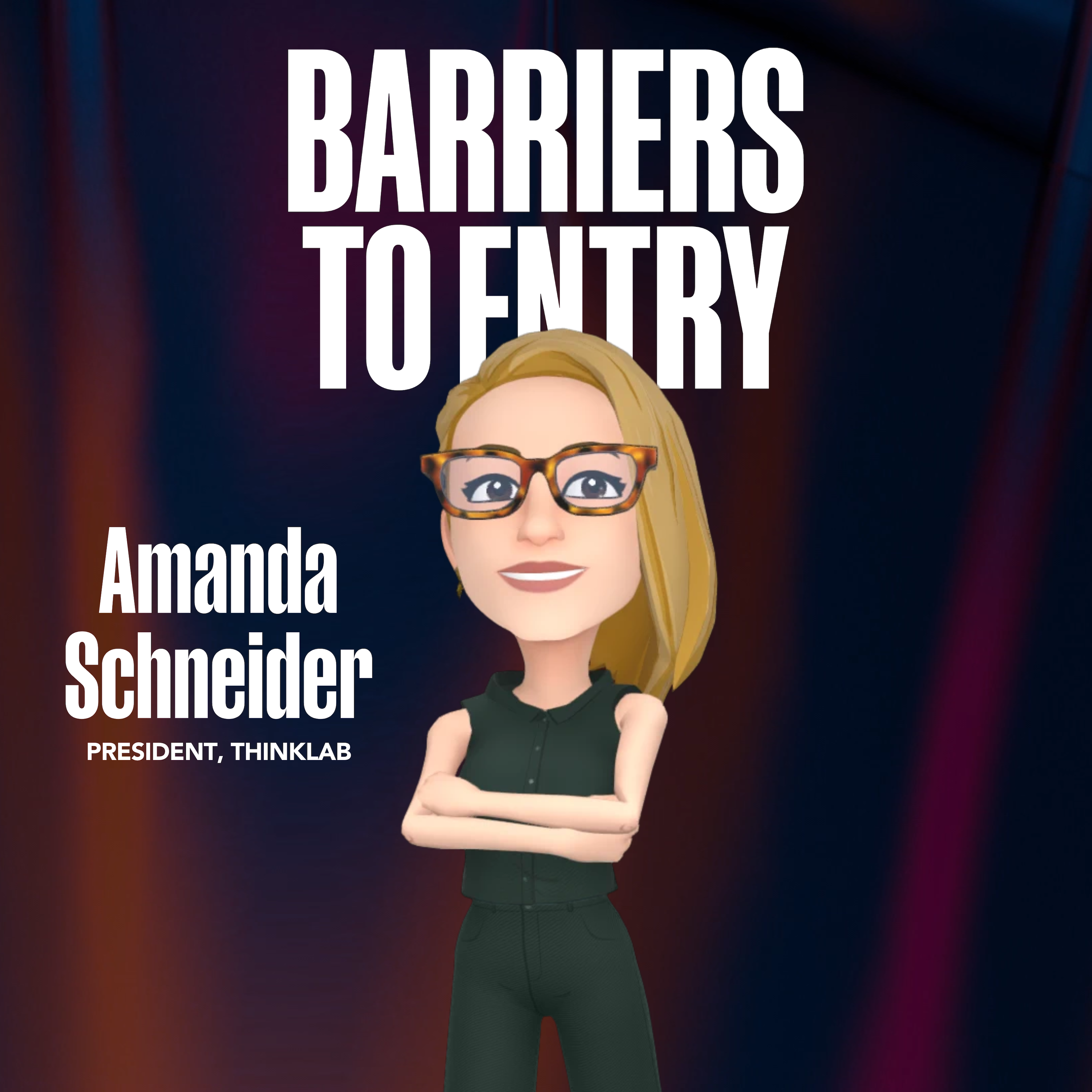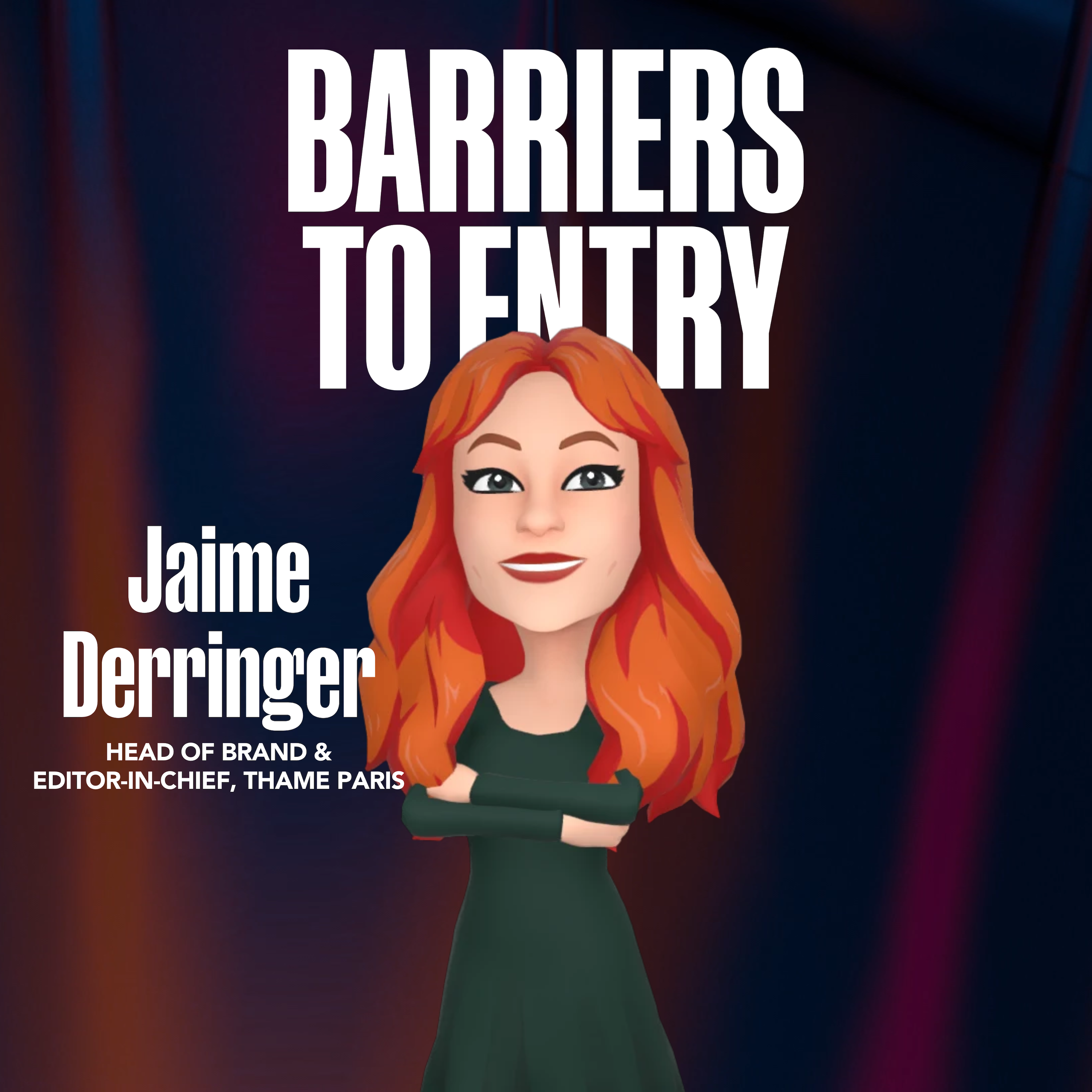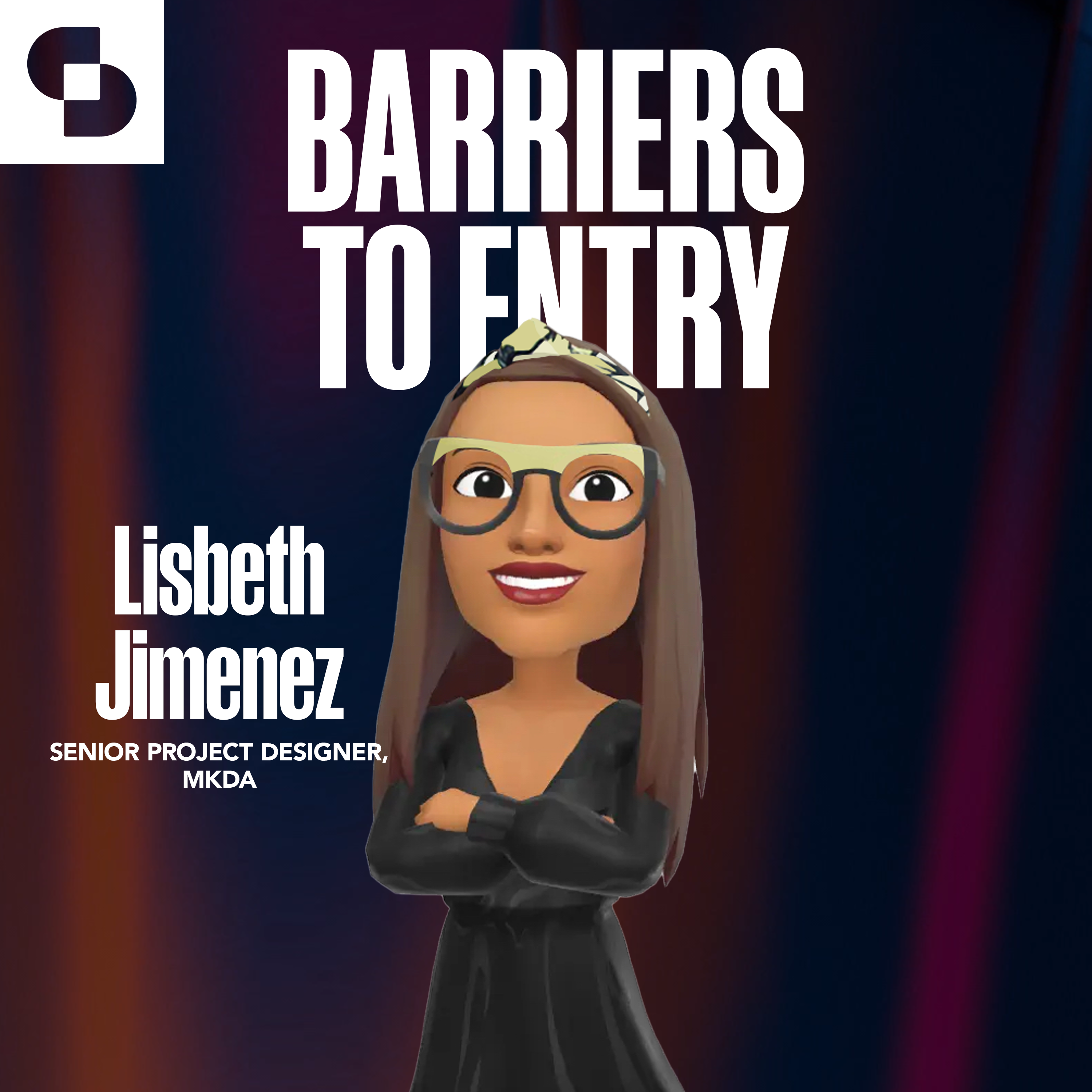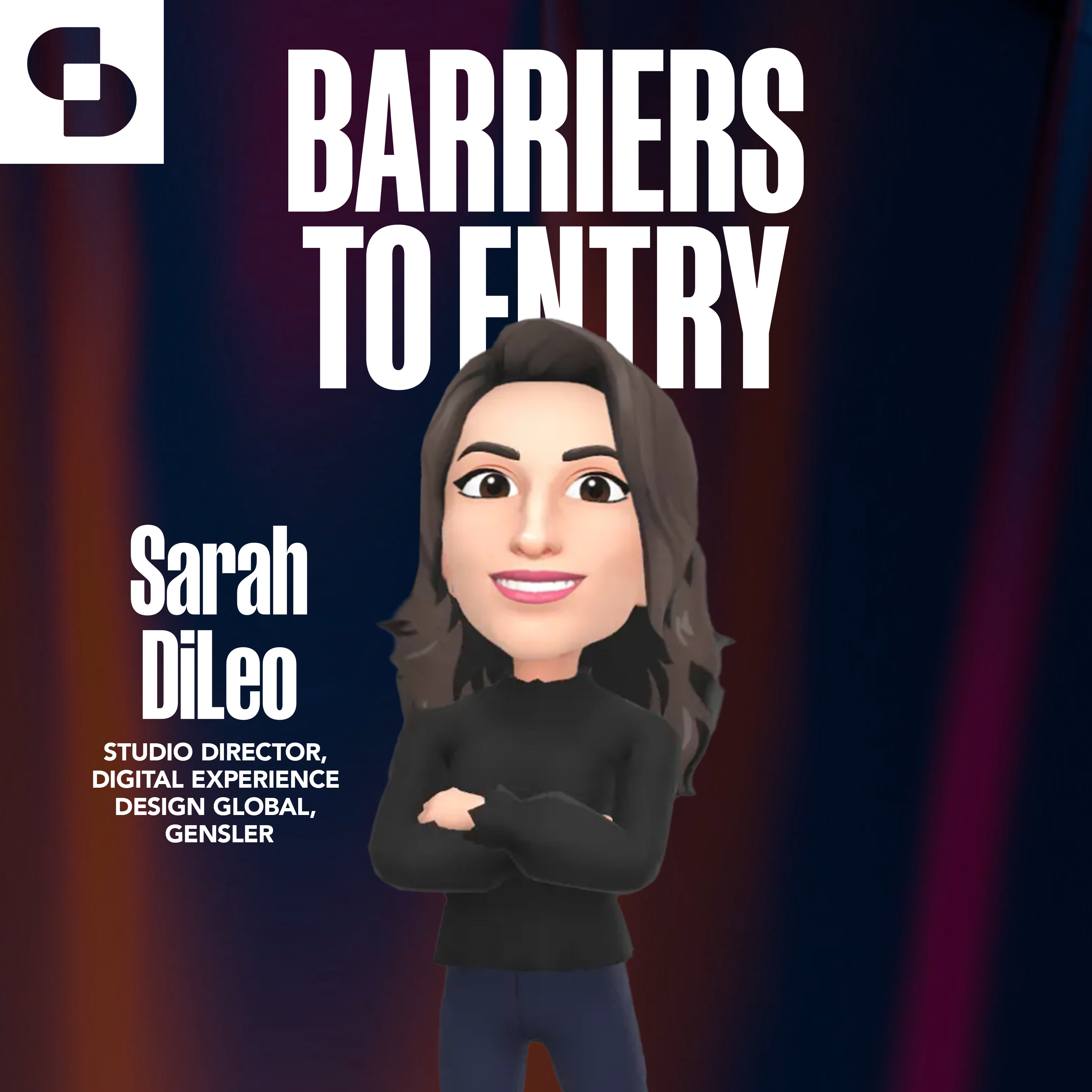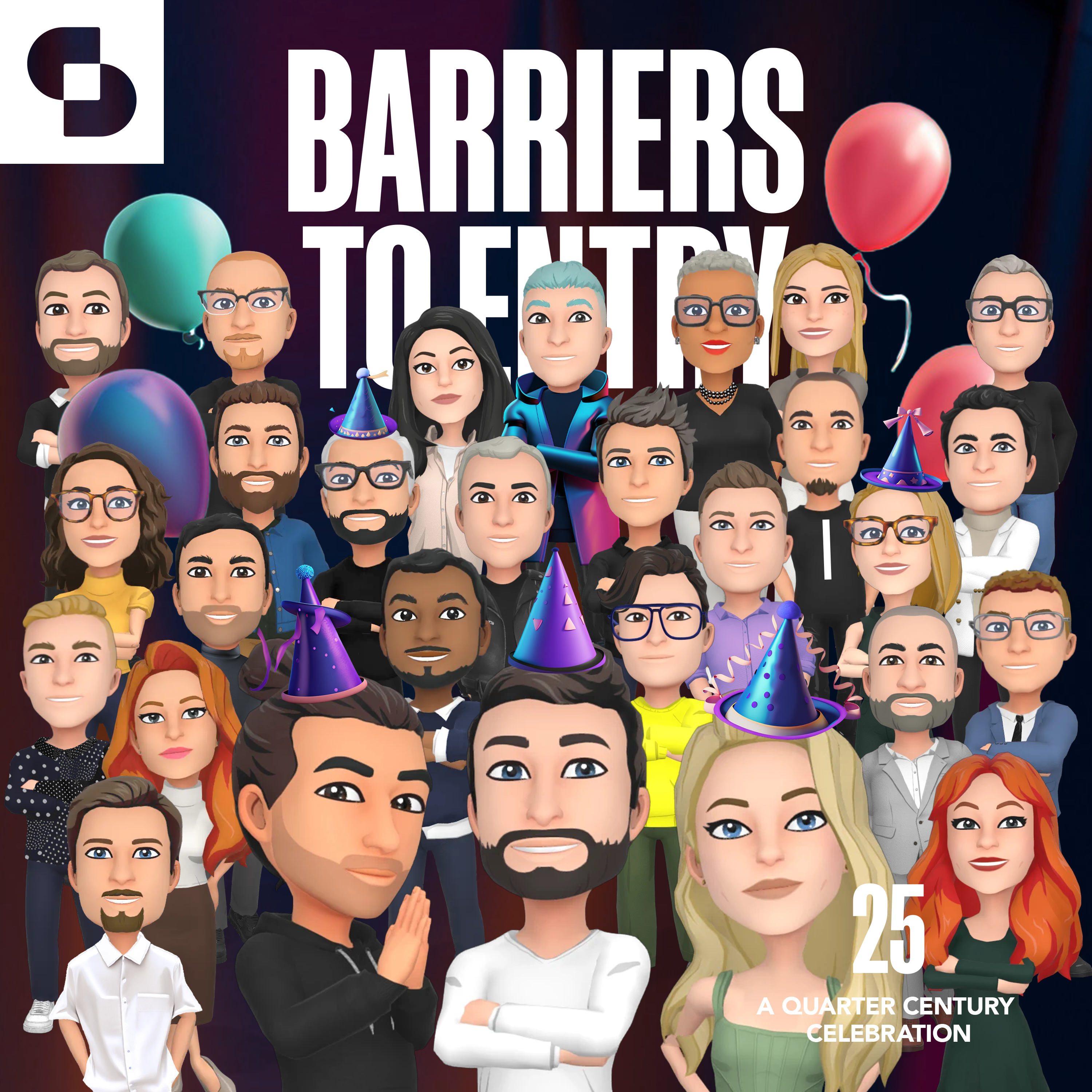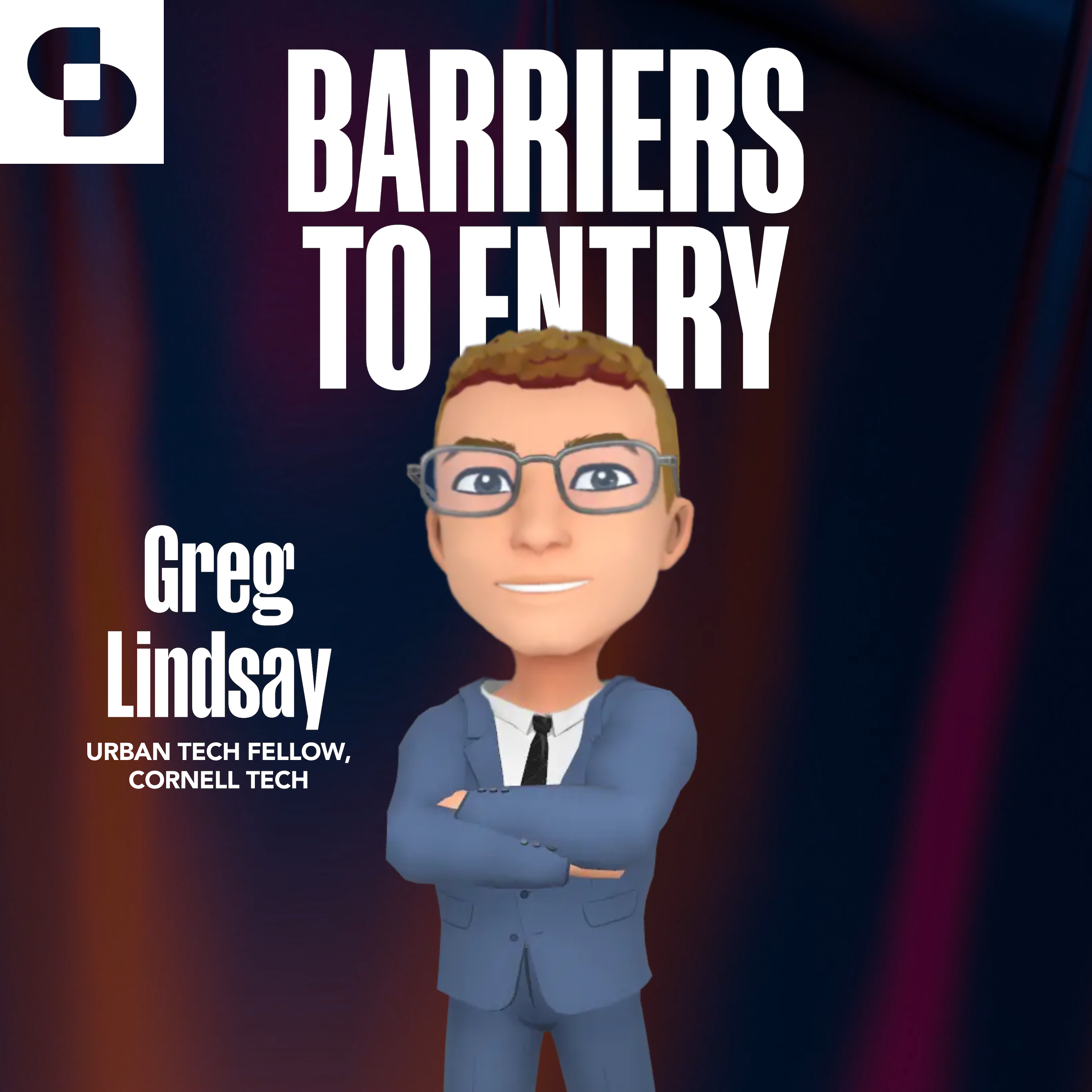This week, the gang is joined in-person in New York by a classically-trained, multidisciplinary designer who is always pushing the envelope and finding new ways at his shop, RADS Studios, to blend the traditional with the digital. Rodolfo Agrella stops by to share stories from his classical architecture and design training in Caracas and Milan, how he used technology to create a cookie at Salone del Mobile, the lesson we were all asked to learn from COVID, and how he’s integrating technology into daily practices to unlock the power of classic design. You won’t want to miss a great conversation with this eternal optimist and innovator.
Connect with Rodolfo Agrella on LinkedIn!
Moments to check out:
- (8:38) How international architecture design training created a cookie at Salone
- (16:19) Establishing RADS and putting talent and innovation at the core
- (22:58) Applying AI and technology to design thinking
- (32:20) Re-thinking talent and design collaboration
- (37:15) Rapid fire closer questions – blockchain authentication, ICFF in the metaverse and more
Connect with our hosts on LinkedIn;
References and resources:
- RADS Design Studio
- Rodolfo’s work at ICFF / Wanted
- Don’t forget to speak to your friends and family and learn from them too!
Discover more shows from SURROUND at surroundpodcasts.com.
This episode of Barriers to Entry was produced and edited by Wize Grazette and Samantha Sager.
Learn more about your ad choices. Visit megaphone.fm/adchoices
Rodolfo Agrella: [00:00:00] you’re all surrounded by technology and we, I’m a user. of that. the big. question here, and I always, have these conversations with my team, how arewe using technology and the digital world to enhance the physical
Bobby Bonett: Welcome to Barriers to Entry, the podcast where every episode we get into it with the leaders, the designers, the early adopters, and the influencers who are driving innovation in the architecture and design industry. It’s the metaverse. It’s AI. It’s blockchain.
Bobby Bonett: And it’s all happening here. I’m Bobby Bonet and as always, I’m joined by my reality TV loving co hosts, Andrew Lane and Tessa Bain. How y’all doing today?
Andrew Lane: We’re doing great, but we’re a little behind on Love Island as
we picked up in the pre record there. But,
Bobby Bonett: It’s a shame.
Andrew Lane: well, it’s summer shows, you know, you can’t beat, you can’t beat your summer
Bobby Bonett: When does summer end? When does summer, is this still the
Andrew Lane: When does this, when does the summer of [00:01:00] BTE end is really the question
Bobby Bonett: What’s your, what’s your take, Tess?
Tessa Bain: like, as soon as the weather shifts, we’re starting to think about fall, my shopping cart’s full of cardigans. I think the summer of BTA’s starting to come to a close.
Andrew Lane: that’s a really, bittersweet sort of a statement, but I, I like to think we go all the way to, is it called the, the, uptunnel equinox? The, the 20th,
Bobby Bonett: The what?
Andrew Lane: that’s an equinox. I’m pretty sure
Tessa Bain: Google that?
Andrew Lane: I should, but I won’t. not going to fact check myself for once, but yeah, the 20th of September, the 21st of September, one of those, that’s the official end of summer.
Bobby Bonett: back to school is something we’re looking forward to, in the Bonet household, by the way, right around the corner at this point,
Andrew Lane: Have you already gotten all the pencil cases and everything? Do they still do pencil cases?
Bobby Bonett: there’s, even though we have AI technology at our fingertips, even though we have, you know, the power of the metaverse surrounding us, you still walk into school. With a little pencil case with your backpack, with your trapper keeper. so the girls, they’re ready to go, but today enough about my kids, who do we have on tap today, Andrew, for our episode [00:02:00] guest,
Andrew Lane: Well, I was going to say it’s a lot like what you were getting at, Bobby, mixing the old with the new, we’ve got renowned designer who is really taking the classical practices of design, who, you know, went through a very, very classical training between his home country in Venezuela, making his way to Milan, and then now residing in New York City, really doing some exciting work that Fuses in a lot of the technology and the innovation that we’d love to talk about on the pod. So it’s super exciting to have Rodolfo Aguela, from Rad Studio joining us today for what I know will be a really eyeopening conversation about the way in which traditional medium design.
Can be influenced by these technologies. and really, you know, how Rodolfo is bringing it into practice right now.
Bobby Bonett: should we get into it?
Andrew Lane: I think we should
Tessa Bain: do it.
Andrew Lane: We are hanging out live in Vornado’s Pen One, podcast studio in New York City with Rodolfo Agrella, a New York based multidisciplinary Venezuelan designer who’s pushing the [00:03:00] limits at his studio RADS and leading exciting work at some of the biggest trade events in the design industry and well beyond as we’re going to find out today.
Rodolfo is passionate about changing products.
He’s also passionate about the future of design, including AI, the metaverse, blockchain, and provenance. Welcome, Rodolfo.
Rodolfo Agrella: you
very much for having me.
Bobby Bonett: we had to start by doing a deep dive though on, on your Instagram, Rodolfo. the aesthetic is on point. We noticed that. and, we saw a little Prince, a little George Michael, a little Aretha. Does music play a role as a point of inspiration for you when it comes to your design
process?
Rodolfo Agrella: Absolutely. so the music, it’s, for me, it’s crucial. I, we actually have built in in the studio. We have a team that it’s, led by a composer. We do all the soundtracks of everything that we do. even if the client doesn’t need it, we do a video or something. And then the soundtrack that matches that video.
It’s all custom and it’s made in the [00:04:00] studio. so for me, music, it’s super
Tessa Bain: because
Rodolfo Agrella: it guides and
Tessa Bain: enhances the emotion of whatever.
Rodolfo Agrella: these people that I
Tessa Bain: post, they are for sure. Uh, and they
Rodolfo Agrella: were always Somehow in the perimeter
Tessa Bain: of things, like
Rodolfo Agrella: Prince, it’s like that androgynous thing, George Michael, it’s a,
sex symbol for me, and then Aretha, of course.
Tessa Bain: everybody in my family plays
Rodolfo Agrella: something. So I’m not trained in
Tessa Bain: terms of
Rodolfo Agrella: music, but if you give me an instrument, I will play it somehow.
Tessa Bain: So, so that’s why
Rodolfo Agrella: I love music.
Tessa Bain: And I think that’s a, it’s something that.
Rodolfo Agrella: everybody enjoys. It doesn’t
Tessa Bain: matter the language or your culture.
You’re gonna always get connected to a sound.
Andrew Lane: we were walking up with Rodolfo today and he told us that
When this space opened and,
Sandow did the NYC by Design Awards here, [00:05:00] Rodolfo actually did the playlist for that
Rodolfo Agrella: Oh, really?
Yeah, yeah,
Tessa Bain: yeah, I curated like a
two hour
Rodolfo Agrella: playlist about the sound of New York. Oh, wow. And it has
small
Tessa Bain: bites
Rodolfo Agrella: of like the
train station. And then it was a trip from, from Astoria to the Bronx to
Tessa Bain: Soho to, it
Rodolfo Agrella: was really Really cool.
Tessa Bain: Eventually we would just
post
Rodolfo Agrella: playlists in the studio account
Tessa Bain: Yeah. In, uh, in
Rodolfo Agrella: We need to get one of those playlists notes, that’s
Andrew Lane: Yeah.
Rodolfo Agrella: so
talk a little bit more about culture growing up in Venezuela and how that, played a role in
the way in which you approach design
growing up
and now today.
well,
Tessa Bain: people
Rodolfo Agrella: know Venezuela
from like the recent
which is
completely the opposite
my experience cause I grew
Tessa Bain: up in a super
Rodolfo Agrella: wealthy
Tessa Bain: the government
Rodolfo Agrella: at
that time,
Tessa Bain: was, investing a lot
in culture. And everybody
had [00:06:00] access
Rodolfo Agrella: to
that high level I was lucky,
to study at,
Tessa Bain: the Central University in Caracas,
Rodolfo Agrella: which is a marvel of mid century modern architecture.
that was possible
Tessa Bain: of
Rodolfo Agrella: the cultural level whomever built that at that time and make those
so I
was able to just have coffee next to, Stabile Mobile from Calder or to just
Tessa Bain: go around
and see John Knapp’s
Rodolfo Agrella: pieces and stuff, you
Tessa Bain: know, that
Rodolfo Agrella: kind of things. for me, it was
Tessa Bain: for
granted.
until I
moved.
Rodolfo Agrella: Right.
Tessa Bain: And I
Rodolfo Agrella: started to actually, celebrate that. not just the,
Tessa Bain: art,
Rodolfo Agrella: part
Tessa Bain: everybody
Rodolfo Agrella: had access really deep books I remember my family and not just my family, my context, we will have
like deep
conversations
Tessa Bain: about anything, not just
what’s happening
Rodolfo Agrella: in a very superficial level,
why
it’s
the purpose of something or the of [00:07:00] something.
So that a way informed the way that I behave. And obviously like my childhood.
And for me, that’s
something that I maintain daily basis. as a law,
living.
Bobby Bonett: Yeah,
Rodolfo Agrella: and it’s, it’s
because of that.
it’s because I
grew up in this environment, fertile
environment.
Andrew Lane: So, where did you move to next? Like, what was, you know, you said you didn’t take advantage until it was
Tessa Bain: gone. So,
Rodolfo Agrella: So,
Andrew Lane: know, what was the inspiration to move on? Well,
Rodolfo Agrella: you know
Tessa Bain: that, we as humans are very, I don’t know
what would be the best word to describe this, but like, we always
Rodolfo Agrella: criticize. the immediate
ah, sucks, ah. And when I was studying architecture, scholarship, that, the faculty, just invite
Tessa Bain: me to be
Rodolfo Agrella: part this, exchange program.
So they
Tessa Bain: will,
Rodolfo Agrella: allow me to study two years in Milano, at the Politecnico. I studying [00:08:00] architecture and then we, and
I was like, yes, yes, because the education here sucks and blah, blah, blah.
was a kid.
and then
when
I moved to Milan,
I
Tessa Bain: realized that
Rodolfo Agrella: the level of the
education received In was high
The fact that I was once again, just coffee
next
to Peace Milano that was What?
That’s a huge luxury
So
when I was living there, I could tell, okay, well, I’m very fortunate I have this thing, and now that I
Tessa Bain: can, get it, I really appreciate
Rodolfo Agrella: it.
And then,
obviously when I decided to New York
in 2014, I realized that I came with that, baggage in a way, and that, set of gratitude for my roots, and just
keeping
Tessa Bain: a
Rodolfo Agrella: foot there
and the other one in the future, I
would say.
Tessa Bain: can you tell us a little bit about the roots of starting [00:09:00] RADS and specifically the work that you’re doing today in the studio? Is it what you expected you would be doing when you were
studying?
Rodolfo Agrella: Not at all. Not at all.
I decided study architecture because the option was either, civil engineering.
or no to say,
Tessa Bain: for any civil engineers out there.
Rodolfo Agrella: Or, like, graphic design or
art.
And then
architecture
Tessa Bain: presented
Rodolfo Agrella: itself as a,
Tessa Bain: meet ground
Rodolfo Agrella: there, where you can… do either engineering or more artistic
in terms of approach.
in, the
Central University,
the way architecture school approach the career is that you are presented with a, set of tools and you use it.
Tessa Bain: however
you want it, in the way
Rodolfo Agrella: you want it, in the discipline And then that was highly reinforced when I
moved
to Milano
Because some
reason,
people live and
breathe
Tessa Bain: design.
Rodolfo Agrella: and, architects are in charge
of that. Not just
to build
a, uh, building, [00:10:00] but also to
build
the way
society so
in a
way, I wasn’t aware of these, like, super profound things.
It’s like I was having fun, starting like a super nerd because I’m very nerdy. and then after that, period time in Milano, I got back Caracas that part of the deal. I got my,
title in Caracas and I
started work
in
different, studios, offices
there.
and I realized that I had more fun.
designing the rails of a building or understanding, how to of
this
presentation, where are we
put floor plan, we put in
Tessa Bain: the
Rodolfo Agrella: text, where are we putting, you know, the images.
And
then I
started to realize
Tessa Bain: that doing
a
Rodolfo Agrella: layout
for a graphic for
a printout or
Tessa Bain: a
Rodolfo Agrella: portfolio.
was the
Tessa Bain: as doing a building So because you work
Rodolfo Agrella: tension,
you
that
Tessa Bain: structure,
Rodolfo Agrella: you work with color and, and you know, negative space
and so on.
And
I was like, okay, well.
this [00:11:00] happens
here.
but it also
Tessa Bain: happens
Rodolfo Agrella: in the details of the small things.
Tessa Bain: then,
Rodolfo Agrella: in
one these studios, they were doing like design as well.
it okay, well, we’ll help
them.
to do that.
because the to
design a building and build it
Tessa Bain: as an architect,
Rodolfo Agrella: it takes years, years. And I was super
Tessa Bain: bored.
You
Andrew Lane: And I was super poor. There’s a few on this podcast that have some ADD,
Rodolfo Agrella: so
Oh my God, we’re with
Andrew Lane: you on that.
Rodolfo Agrella: so, for it was like
a,
really interesting way to approach
my
career.
I have a title. need do something with
and he was like, okay, I’m
going to, take
to
the
Tessa Bain: core,
Rodolfo Agrella: and start using these tools
the want it.
so,
thanks
to
Tessa Bain: a
Rodolfo Agrella: workshop
that happened faculty, because I was by then in 2009, 2010. I was a
teacher there they [00:12:00] invited
the
Campana brothers
to Caracas to do a workshop of
furniture design
So it was, just 10 people that they
invited
Tessa Bain: and I
Rodolfo Agrella: one them. Again, super grateful that opportunity.
but
the, the Campana brothers
went
to Caracas
because of
Marva
Griffin,
which
is
the
curator and creator
of Salón Satélite
Satellite in Milano.
And she
happens to be Venezuela
and she’s like
a, I top
notch of what
design
is.
She lives and design. and
then
by
the end of workshop, she was You know, at pieces
that we created
was
like, Hey,
you, Rodolfo, you should
apply for Salon Satellite the next year. This piece, it’s really
good. And I was like,
did a table it was like,
Oh my God,
this is so crazy.
So I
applied.
and in order apply, you send a project, or
either
reading. designed [00:13:00] or produced or something.
Tessa Bain: because the
purpose of that, show, it’s just to
connect.
young designers
Rodolfo Agrella: with,
manufacturers,
Tessa Bain: so you need to present something that it’s not, it hasn’t been
Rodolfo Agrella: produced.
Tessa Bain: so I said, okay, well, yes, let me keep this idea of
non-traditional things. So,
Rodolfo Agrella: But
Tessa Bain: want to
show my essence and my, that was a
very intense thing. I said,
I’m Venezuelan, so I need to
take
this to
the international world, whatever. so I designed
a
Rodolfo Agrella: cookie.
Tessa Bain: So
Rodolfo Agrella: it
was more about an experience, an ephemeral So, it was a really interesting thing because
the was like,
I
Tessa Bain: love to cook.
Rodolfo Agrella: Yeah. Is
Andrew Lane: like, is this like chocolate chip or I’m
Rodolfo Agrella: just,
I really
like cooking so I’m trying to culture this
This is actually a cracker. Okay. A cracker that works as a fork.
so it’s made
Tessa Bain: of
Rodolfo Agrella: cassava flour,
Tessa Bain: which is
Rodolfo Agrella: [00:14:00] huge in, in Venezuela and cacao powder.
Tessa Bain: So
Rodolfo Agrella: it was a
black piece that has a groove on it so you can put it of a bowl or just like play with it. Because my idea was like, I wanted people to be able to play with food. you know, Doritos have this like.
Triangular shapes that somebody designed that
Tessa Bain: and
Rodolfo Agrella: it’s, a triangle for a reason because the tortilla,
it’s a circle. So it’s the easiest way to do it. So
Tessa Bain: there are a lot
Rodolfo Agrella: of
Tessa Bain: design
Rodolfo Agrella: components in food.
Tessa Bain: that we give
Rodolfo Agrella: for granted. You cut a tomato in a specific way
Tessa Bain: to do a
Rodolfo Agrella: specific sauce.
You don’t chop the tomatoes in like little cubes
to put it on a
burger.
Tessa Bain: Because it
has
a
Rodolfo Agrella: it
so there’s design
in every,
Tessa Bain: aspect of life.
Rodolfo Agrella: And for me, just to go to a furniture fair, To present a cookie for
me,
it was
being a
a a
a rebel, but
a rebel
with
a heart because
Bobby Bonett: The sweetest
Tessa Bain: the sweetest kind of rebel.
Rodolfo Agrella: [00:15:00] in
my a sentimental one.
Tessa Bain: Yeah.
Rodolfo Agrella: So,
That
me was like, the gateway, and just the seat,
what we do right now at the studio. and we are more and more trying to push
these
boundaries and it took me a little bit to be honest, because once you
Tessa Bain: move
Rodolfo Agrella: From
your,
standard
context, passing from Caracas to, to New York.
Tessa Bain: I
wasn’t planning
it.
there
are
certain…
Rodolfo Agrella: things that you need to learn in order to actually
communicate something
that
people could
and I was highly,
highly
about my, my English accent. I was like, Oh my God, don’t want
anybody to feel that I’m, know, a
foreigner,
It’s
like,
opposite.
that’s what me
be me.
And weird accent, or
not,
or whatever it’s,
speak
many
languages
Tessa Bain: at this point.
And I don’t feel afraid of that. And then that [00:16:00] situation
Rodolfo Agrella: with
Tessa Bain: the languages
is also,
extrapolated
to the design field.
cause yeah, maybe you,
you’re
Rodolfo Agrella: not
the
best, uh, ergonomic,
Tessa Bain: person
or like a specialist, but
you know.
Rodolfo Agrella: when
something works or
Tessa Bain: not, so in a way, it was that,
the Latin
Rodolfo Agrella: American
route,
Tessa Bain: and,
sort
of like discomfort of, of being in
Rodolfo Agrella: a
sell or just like
Tessa Bain: segmented or just, I’m just going to do architecture and I’m going to be very serious
Rodolfo Agrella: with
No, no, no, no. I like you.
Impression architect. Yeah.
Bobby Bonett: I’m
Tessa Bain: I’m serious.
I’m super serious
He would even laugh
Rodolfo Agrella: a lot.
Andrew Lane: So, you know, it’s really interesting to hear an exciting and traditional background in
Rodolfo Agrella: Milan, in Venezuela.
Andrew Lane: Now
you’re in New York. you also came up through a period where digital has really kind of transformed the medium in a lot of ways.
And I know you think about that deeply and, the big topic that we want to touch on with you today is these emerging areas of technology that are now becoming a part of, the work you do at [00:17:00] RADS. So can you talk to us about what that evolution? From, you know, your cookie, at Salone through to the kind of work that you’re doing today.
Rodolfo Agrella: And
Andrew Lane: like, what
was that
evolution? How did, people come along with you in that journey to trust you through the, some of that, experimentation as well,
Rodolfo Agrella: Well, Experimentation and
trust are
crucial
terms this
in terms of dealing
with
you need to build trust. So the
Andrew Lane: clients allowed
Rodolfo Agrella: you to
play,
basically
the cookie experiment was a game
for
- but that at that
time
we’re talking
Andrew Lane: 14
Rodolfo Agrella: years at this point.
we did a lot of digital. and use a lot technology in
order
to develop the of that
cookie,
because that cookie needed be baked in something that looks like a, I don’t
know, it’s
a
rounded, piece
of
like stainless
steel was a huge process.
order to do we
have
to do like laser cut.
And then
we
were like,
Oh
the tip of the iceberg
because
like [00:18:00] laser to cut It’s
natural for me. I mean, I’m not 70. you’re all surrounded by technology and we, I’m a
user. of that. the big. question here, and
Tessa Bain: I
Rodolfo Agrella: always, have
these conversations with my team, how
are
we using
technology and the
Tessa Bain: digital world to enhance
Rodolfo Agrella: the physical Because 1%
physical, where
everything this
world, it’s like
a
3D thing,
has materiality. to access the digital
you
Tessa Bain: need
Rodolfo Agrella: a
a physical equipment to that.
so
there are many
possible ways this conversation can go. There
the
development of that product that allows you,
Tessa Bain: to get
Rodolfo Agrella: into the digital world
the use.
of that digital
tool
to enhance
and facilitate, [00:19:00] a
Tessa Bain: design
Rodolfo Agrella: process.
so
It all
comes out
of,
you
know,
needs,
obviously. my
team, scattered around the world. and
I’ve
been
working that way for, for a long time,
even before COVID. COVID.
Andrew Lane: Even was fashionable.
Rodolfo Agrella: Yes, exactly. The pandemic was, feel it was a blessing, because it allowed, see, I’m always joking, quote, unquote, it’s like.
universe
said to humanity, go to
your room
and rethink
because you
are not doing it
Tessa Bain: well.
Rodolfo Agrella: And then
I feel like the people, we were all
forced
to pause, rethink we’re
doing.
rethink What do you actually need to leave
And
how are you behaving and, and what are you
living?
because we all
have a purpose
here.
feel like
I’m preaching.
but it’s like
A little bit.
Andrew Lane: It happens it’s the
podcast
Rodolfo Agrella: podcast
media.
Andrew Lane: meant for this, you
Tessa Bain: This is your moment. [00:20:00]
Rodolfo Agrella: so, before that, before, 2020, my was around the world because, you know, I know a lot of people around the world and I, really, Like
to work
with good
people.
I’m
not working with somebody
because it’s
here in
New York. I’m working with because it’s
good
at a And
Tessa Bain: brings something extra to this.
Rodolfo Agrella: know,
mix, of
disciplines or like perspective
that helps
my studio
attack
things
from multiple And
that’s makes us
good, a way,
Because we tackle design stuff from a photography perspective.
or from a, sound
perspective.
so,
Tessa Bain: it was
crucial
Rodolfo Agrella: to work with
a
digital tool that allowed this collaboration
to happen
Tessa Bain: and to
feel that
we’re
all
Rodolfo Agrella: together.
is very hard to
do.
for
me, what
happened during
pandemic I had to
deal [00:21:00] a
lot We had a
lot
of clients
time
that I was like, well, we’re screwed because, this is all about going to a
Tessa Bain: manufacturing
Rodolfo Agrella: facility
look
Tessa Bain: for and see
stuff.
Rodolfo Agrella: And,
I rely a lot on personal connections in terms of, you need to
build that trust, in order
for people to,
to accept your,
perspective on
things.
and, that trust
it’s generated out of conversations and, you know, feeling the energy of the other person.
that’s
super
hard to do
with
a
So I
had to develop a lot of
patience,
Tessa Bain: in order to,
Rodolfo Agrella: okay, how am I using this tool proper way?
so, but I think that over time and over. Zoom after zoom,
after
zoom . I think
that we, achieve a point okay, well
this is
it’s,
falling a little bit short. what else
can we do?
to keep connected
so we use many other tools,[00:22:00] that help us, work efficiently. I’m not talking about management. Soft or anything like that,
essentially, for
Tessa Bain: my
Rodolfo Agrella: perspective on that, it’s like you’re starting to cluttered
digitally, you’re
surrounded
by
a lot of digital trash, and that
in a
Tessa Bain: way for me,
Rodolfo Agrella: every time that I,
particularly think
The pandemic and how many times
I,
I was redoing my closets and
trashing
stuff
and just
cleaning
after cleaning,
after cleaning
after cleaning, I realized,
Tessa Bain: yeah, I just,
Rodolfo Agrella: I just need these couple of pens and couple of
Tessa Bain: shirts and that’s it.
don’t need anything I felt the same way, like this experience of minimalism, like what do I really need all this for?
Rodolfo Agrella: interesting
thing
is that
it’s not a minimalism
you need
only specific things. a matter
of
Tessa Bain: restraint.
And that’s
something
the minute I [00:23:00] identify that, It was like, okay, I’m applying this
Rodolfo Agrella: to everything.
Tessa Bain: And I’m,
Rodolfo Agrella: time
that I
have meetings with all
my,
the clients,
the internal meetings with the team, it’s guys, it’s about
Restricting.
Bobby Bonett: Getting rid of the noise.
Rodolfo Agrella: Correct.
Bobby Bonett: Yeah.
And
Rodolfo Agrella: that’s super hard.
Tessa Bain: So, how do you do that today? Like, how do you apply these emerging technologies to the work you do then in terms of the design process and how do you narrow down all of those tools?
Rodolfo Agrella: Well, it’s a matter of how
Tessa Bain: efficient
Rodolfo Agrella: a tool is.
And
what’s the purpose
of what
we’re
doing? there is something that crucial for me
in terms
of
Tessa Bain: using technology and,
and embracing
Rodolfo Agrella: technology. that you need
a criteria
behind the of that.
same
with AI.
Tessa Bain: everybody’s scared about AI.
Rodolfo Agrella: It’s like, oh my god, what’s gonna happen, ah.
Tessa Bain: well that’s what we wanted to ask you about that today too, specifically. I mean, we’re in the middle of the revolution of AI, but specifically [00:24:00] from an ethical perspective, from an IP perspective, I mean, how do you approach that?
Rodolfo Agrella: Listen, people get freaked out I
narrow two One, because cannot what’s happening.
So if I cannot control
it,
I’m gonna.
you freak out. and other one
is because they don’t see
the,
results of it immediately. this
is a
baby that it’s walk.
Well, I don’t know
if it’s starting to work. It’s just barely breathing
at this point. the good
thing and
and the way it the studio, it’s like we use AI to process
a lot
of
information
information
In an
efficient manner, in a, it’s super fast.
Tessa Bain: but
what happened
Rodolfo Agrella: that the
efficient that,
at least from
my perspective,
is that
need
somebody behind that.
Because
Tessa Bain: when you’re doing a
Rodolfo Agrella: mid
Tessa Bain: journey,
image of,
Rodolfo Agrella: I [00:25:00] don’t know,
Tessa Bain: a building that
Rodolfo Agrella: looks like a cookie,
Andrew Lane: we’re all
Rodolfo Agrella: waiting
for, made of gluten free flour. Exactly. Exactly. Exactly. Somebody the prompts
Tessa Bain: there.
So it’s not like,
Rodolfo Agrella: a
self
generated
thing.
Andrew Lane: Yeah, it’s not Skynet Just yet.
Rodolfo Agrella: Correct. Exactly.
Just yet.
that’s, an important thing, but
We need to live in the present,
thinking the future, but
acting in the So what’s happening now is that, yes, everybody’s freaking out, but
Tessa Bain: the thing is that, well, I see a,
Rodolfo Agrella: I see a horse there.
running. Somebody,
at
some point in human
history,
went
Tessa Bain: that
horse
Rodolfo Agrella: and says, I
can, can on top of this.
And then, know,
the rest
is,
is history.
so I
feel
Tessa Bain: that’s
Rodolfo Agrella: what’s happening with ai. we use it in a way
that help us confirm the
ideas.
[00:26:00] we don’t use it. As
a main.
design tool, because our main design
Tessa Bain: tool,
Rodolfo Agrella: it’s our
brain.
Tessa Bain: Do you feel if you used it as a design tool that that, you know, would be controversial or would be loaning IP or like, how do you feel about Yeah, actual application of AI in design.
Rodolfo Agrella: I don’t mind. It’s
Tessa Bain: another
Rodolfo Agrella: It’s
Tessa Bain: another
Rodolfo Agrella: and it’s a necessary tool because
the, bigger
the, the communications
the world and the globalization, is a lot
of
Tessa Bain: information.
Rodolfo Agrella: there
And we some sort like a filter to process that information.
Before, there were
like libraries
And
people would go to
the
library and
spend months
just to,
Tessa Bain: look through, Publications
Rodolfo Agrella: and stuff. Well, this is the best example.
When,
Tessa Bain: newspapers
Rodolfo Agrella: started to
do digital, formats,
everybody
was
freaking out because, this [00:27:00] is the end of
printing
in life! Ah!
Tessa Bain: Well, no.
Rodolfo Agrella: It’s not the end. It’s an evolution.
Now, if you have a book, it’s because it’s a piece.
It’s an
object.
It’s
Tessa Bain: object
Rodolfo Agrella: that holds information.
obviously
you can reach out to more people digitally, which help us connect. But
once again,
there is a criteria
behind that,
the use of that
Tessa Bain: so
Rodolfo Agrella: the studio,
what we do, it’s just like, okay, we need to do this thing.
We’re trying to achieve this
thing, X, on a of
time.
We can do it
Tessa Bain: in two ways.
We use technology
to help
Rodolfo Agrella: us, or
Tessa Bain: or we just,
Rodolfo Agrella: like, need
Tessa Bain: invest
Rodolfo Agrella: more time,
Tessa Bain: in order
Rodolfo Agrella: to confirm
Tessa Bain: For me, the important part
of this whole
Rodolfo Agrella: puzzle is that in the end,
Tessa Bain: whatever we do,
it has [00:28:00] physical repercussions.
And we design for a physical
world.
And the digital is there to enhance,
to
facilitate that.
It’s not
the, the, the, the main fear is that, Oh,
all of
these like
AI and like Web3, all of
Rodolfo Agrella: that.
Tessa Bain: The
metaverse, it’s gonna,
Rodolfo Agrella: Right, we’re all going to be living in the metaverse. Yeah,
Andrew Lane: that we need to
yeah, replace
Rodolfo Agrella: one with
Tessa Bain: No, that’s not,
it’s, it’s
not about
Rodolfo Agrella: replacing. Right.
Tessa Bain: It’s about embracing.
Andrew Lane: Ah, there
we go.
Rodolfo Agrella: there’s a new tagline
Andrew Lane: the pod.
Rodolfo Agrella: for the pod. T shirt, T shirt. Casey, work on that. I’ve already… I’ve, I’ve, so… you seem to
Bobby Bonett: be
in a really great
headspace right now it relates to where AI is being adopted and leveraged at RADS. I think many of the designers talk about
are
leveraging AI in
their firm
Rodolfo Agrella: have
Bobby Bonett: shifted
mindset from AI is, design tool to AI is a [00:29:00] data tool or AI
Rodolfo Agrella: as an enhancement to the design
Bobby Bonett: process.
But we were at a conference yesterday. and when you speak with people in the room who, who are, who are still intimidated by AI, like Tess was saying, I think they still view it as.
AI is going
to be a button that I push and
it takes
Rodolfo Agrella: my
Bobby Bonett: job away, or,
Rodolfo Agrella: becomes
the de facto
Bobby Bonett: new
design process.
And
I’m wondering,
Rodolfo Agrella: like, when you first dove into AI, how was your perspective different and a little bit about where, where you,
Bobby Bonett: Where your journey
Rodolfo Agrella: you at RADS and as a, as a firm leader to get to where you are now, which is well adjusted and you’ve made peace with the fact
that there
may be some
unknowns
coming, but you’re, you’re in a good place with your studio.
That, that, that path started with… Embracing the unknown.
Tessa Bain: I don’t know what this is, but I know
it’s
Rodolfo Agrella: here
Tessa Bain: and it’s,
Rodolfo Agrella: it comes to
Tessa Bain: stay.
So
Rodolfo Agrella: let’s
Tessa Bain: give it a shot without
any
Rodolfo Agrella: pre judgmental mindset.[00:30:00]
I think that’s
Tessa Bain: Listen, I,
I,
when I
was studying
architecture,
Rodolfo Agrella: the first
semester,
Tessa Bain: we were obliged
to do
all the
drawings by hand. By hand. Dude, that was
20 years ago, like
everybody
could use AutoCAD.
and we were all
really,
as young kids,
Rodolfo Agrella: saying,
Tessa Bain: Oh
my God,
but
Rodolfo Agrella: there
are all of these digital tools. And I remember
Tessa Bain: clearly my teachers saying, If you
cannot draw it by
Rodolfo Agrella: You
don’t know
how to draw it
in digitally,
which true.
absolutely
true.
there are certain
aspects
of
that, of a drawn,
plan, yes, it has character. It has, the human touch.
it’s more efficient the
way.
With
these emerging
technologies,
it’s
basically,
yes, we’re using it,
but
that cannot
[00:31:00] be the only
Tessa Bain: thing to use.
It needs to have many, many layers, which one
of
these layers,
Rodolfo Agrella: it’s provided by several, new technologies
Tessa Bain: and new platforms And,
keeping in mind
Rodolfo Agrella: that
person that controls
this, whomever controlled this,
Tessa Bain: it’s you,
Rodolfo Agrella: a human.
Tessa Bain: It’s like
we are… bombarded about
the future,
and it comes up,
Rodolfo Agrella: and I think
that’s,
Tessa Bain: that’s
that’s because of the
Jetsons, to
a
Bobby Bonett: start. that
Andrew Lane: the Jetsons every day,
day.
Rodolfo Agrella: a certain
Tessa Bain: that, you know, we’re
going to be all controlled by robots,
and
in
a way we are already. You just don’t know it. it’s a matter,
well,
that
Rodolfo Agrella: robot, let’s say that the cell phones, come on,
Tessa Bain: everybody has it. and 20
years ago,
Rodolfo Agrella: you would never imagine that you will
Tessa Bain: answer an email or
like
Rodolfo Agrella: listen to
Tessa Bain: music or whatever
from that, you know,
a
three [00:32:00] by
Rodolfo Agrella: six inches device.
Andrew Lane: Oh, exactly.
Tessa Bain: And
it’s a matter
of
not
Rodolfo Agrella: being afraid
Tessa Bain: of that, uh, because
it’s a, it’s, people that it’s
Rodolfo Agrella: like very,
Uncertain about these
Tessa Bain: and they’re
scared. It’s
Rodolfo Agrella: It’s because,
Tessa Bain: nobody has
fully proved.
Rodolfo Agrella: that this is successful or And
the
only
way to know that is
trying it.
Tessa Bain: You don’t
know if you like,
I don’t know,
oysters if you don’t try them.
Try them,
and then you make your decision
and
Rodolfo Agrella: that’s
it.
as
Andrew Lane: you’re doing some of this experimentation, are you thinking differently about
the construction of
your team and the kind of, the kind of talent and personalities that you’re bringing in to collaborate
Rodolfo Agrella: Well,
yes.
Tessa Bain: but
that’s been always a thing. I’m a Libra.
And
Rodolfo Agrella: so I
Andrew Lane: you
Rodolfo Agrella: Why are you looking at me?
Andrew Lane: are Tess
Bobby Bonett: with,
Andrew Lane: Tess Answers [00:33:00] far too many questions with, I’m a Capricorn, so
Rodolfo Agrella: So I really like to, you know, I mean, it’s all about justice.
Tessa Bain: I don’t like conflict.
Rodolfo Agrella: Even if I have to pass through something, I want to hear everybody’s opinion and just like make a decision or blah, blah, blah.
Tessa Bain: so I love
beauty and
that has a lot of
influence in the people that I hired to be part of my group.
and, one of the,
the the first
Rodolfo Agrella: thing that I,
test
Tessa Bain: on
the
people
that is,
you
know, either willing
to work
Rodolfo Agrella: with me or
I’m,
Tessa Bain: really, attracted to their,
Rodolfo Agrella: talents, that
how flexible
Tessa Bain: are you?
need to be, your mind
needs to be flexible,
Cause if
you, in the design
world, if you
are
not
flexible.
You’re screwed Because
you need
to
Rodolfo Agrella: move out of comfort in order to embrace new technologies [00:34:00] without feeling, you know, uncertain or whatever. It’s actually exciting.
so that’s the first thing.
like that And then, What other things are you
Tessa Bain: bringing to the table that it’s not
Rodolfo Agrella: that you are a great, designer?
Tessa Bain: Do
you play
Rodolfo Agrella: something?
Tessa Bain: Do you like to
Rodolfo Agrella: paint?
Do
Tessa Bain: you,
Rodolfo Agrella: are you into fashion? Are you into, what books are you reading? What was the last movie that you know,
Tessa Bain: that kind
of
things, It always
Rodolfo Agrella: informs. Do you like to cook? Mm That’s crucial. That’s crucial. Because everything, it’s connected.
Tessa Bain: And
Rodolfo Agrella: I tend to do something on purpose,
Tessa Bain: just to, you know,
Rodolfo Agrella: rough feathers every
it’s like, okay, have… talented, super talented
Tessa Bain: in my team. Thank God.
Rodolfo Agrella: it’s
Tessa Bain: okay, well,
you’re
getting
too comfortable doing
Rodolfo Agrella: graphics.
Tessa Bain: show me
Rodolfo Agrella: an idea [00:35:00] for a But
Tessa Bain: a graphic
Rodolfo Agrella: designer.
Do a
It’s
okay, I’m not, I’m
not
putting all the weight on you. I just want to, to, as
Tessa Bain: an
Rodolfo Agrella: exercise.
Tessa Bain: To
practice this
Rodolfo Agrella: elasticity of mind. And that’s it.
Tessa Bain: Oh, how, how would
Rodolfo Agrella: you
plate,
an ideal,
dish or
what if we do,
Tessa Bain: a
dinner
Rodolfo Agrella: in
the middle of the desert?
Tessa Bain: what’s
Rodolfo Agrella: the, the production aspect of that just
Tessa Bain: to have like a high end
meal in the middle of
Rodolfo Agrella: the desert.
Tessa Bain: it’s like, we don’t do that.
Rodolfo Agrella: we
might.
Eventually. I don’t know. So, so those are the kind of. It’s intimidating. Why?
Tessa Bain: AI, it’s intimidating. Hahahaha!
Bobby Bonett: true.
Rodolfo Agrella: I walked into that.
Bobby Bonett: that.
Rodolfo Agrella: No, it’s a, it’s a. It’s, it’s, it’s intimidating because you’re not used to it.
Tessa Bain: and the best way to
pass through that [00:36:00]
is
literally
Rodolfo Agrella: passing through you know, embrace that fear or whatever. And then there is no right or wrong answer to it. do you find that that also drives collaboration within your, within your firm as well?
Of course, because it’s, it’s presented, it presents itself as a challenge. And
people want
to be challenged.
Tessa Bain: Creative people need
Rodolfo Agrella: to
And
that’s
part,
Tessa Bain: that’s why I
feel it’s so important the
Rodolfo Agrella: restriction
Tessa Bain: aspect
of the design.
Rodolfo Agrella: that’s
Tessa Bain: the first
thing that I
realized
when I
started to work here
in the United
it’s like, here we have
Rodolfo Agrella: access to almost
Tessa Bain: everything,
design
Rodolfo Agrella: wise,
Tessa Bain: and in many
Rodolfo Agrella: other
aspects,
Tessa Bain: too.
Rodolfo Agrella:
the
Tessa Bain: highly
Rodolfo Agrella: successful people is the one that, that
Tessa Bain: reach out
to all of these.
Rodolfo Agrella: It’s different, sources with a
Tessa Bain: criteria
because that
helps you
filter
Rodolfo Agrella: a lot of [00:37:00] so when you
restrict people specific the creative
Tessa Bain: answer
Rodolfo Agrella: is
Tessa Bain: you cannot find
it
anywhere else, because you need to come
up
Rodolfo Agrella: with a,
with an, an innovative solution.
And that’s why innovation in general comes from
Tessa Bain: people
Rodolfo Agrella: outside the discipline where the innovation is
Tessa Bain: happening. Because
they are not
Rodolfo Agrella: biased.
At least, that’s what I feel.
Andrew Lane: And it’s that’s a great, a
great approach. We’ve got a few kind of quick fire type topics we’d love you
to
take. on as we kind of head to the finish line.
Did you want to get started?
Tess?
Rodolfo Agrella: Let’s it!
Tessa Bain: Ready, set, go. you know, in our pre call, we talked a little bit about some of these emerging techs and, the ways you use them and the tools and the value you see. And so one of those tools is blockchain and specifically as a ledger for provenance.[00:38:00] How do you see the blockchain helping the design industry?
Rodolfo Agrella: it’s crucial because
thing
about
blockchain
is that
helps you
trace
Tessa Bain: the
story
and, uh, Well, the provenance of
something.
Rodolfo Agrella: And that’s
Tessa Bain: how I
feel
Rodolfo Agrella: it
Tessa Bain: will be
a,
a more
Rodolfo Agrella: sustainable
thing.
Tessa Bain: one
- its
Rodolfo Agrella: applications in terms of furniture, specifically.
It
also happened with art, fashion, uh, items, it
will help
you
trace
this.
Not
even who
has it before me.
Tessa Bain: who
actually
Rodolfo Agrella: did this?
Luxury
items,
Tessa Bain: They are in a specific price
range
Rodolfo Agrella: because the quality
of the goods.
And that quality
and the craftsmanship
behind a luxury
has
a name artisan has a name
and
you want to [00:39:00] know that even if, I don’t know,
from 15 years from now, if we do a limited edition
Tessa Bain: collection.
With
an
artisan, an upholstered
person
Rodolfo Agrella: in Como,
Tessa Bain: in Como in Italy,
Rodolfo Agrella: in Italy, I want
Tessa Bain: great
grandchildren to know them.
Rodolfo Agrella: that
Tessa Bain: this Giuseppe blah blah blah did this
Rodolfo Agrella: with his own
bare
hands. Right.
So
it’s
a,
it’s
a
Tessa Bain: way to
Rodolfo Agrella: ensure
and to
trace
the human aspects of something. Interesting. Digitally.
Andrew Lane: I think that, that humanity
piece is, is so important and again, staying with more the practical, you told us about an experience you had that was a metaverse type experience, but it was used to collaborate and help create when you were preparing for ICFF this year.
And maybe you can share a little bit about, you know, a lot of people, when they think about the metaverse, they think about it as like, I’m going to go live there or I’m going to, you know,
Rodolfo Agrella: go into a showroom or
Andrew Lane: or whatever, but this was a very practical example of what this technology can allow
Rodolfo Agrella: for.
Yes.
of [00:40:00] people think the metaverse, it’s
like. God.
you know,
it’s Mark Zuckerberg. Yeah, yeah, exactly.
On
a,
on
a field of like cherry blossoms behind. It’s like, that’s not true. It’s a,
there are more
practical ways. So
because we have team around
the
world, the
Tessa Bain: person in
my
Rodolfo Agrella: that makes
all the 3Ds, it’s in Europe.
Tessa Bain: The other one that makes the
graphics,
Rodolfo Agrella: it’s in Venezuela. And then
Tessa Bain: we are
Rodolfo Agrella: all, you know,
around.
So
we
needed a
tool
to
help the production
team of ICFF and
the clients and the everybody involved. huge
take things
ICFF
plus
Tessa Bain: wanted
design.
Rodolfo Agrella: We need to deal with
more than 80 different
vendors.
Each one of these vendors
has
own [00:41:00] expectations.
then plus
Tessa Bain: the production team around it that makes everything happen. So,
Rodolfo Agrella: we basically, did this, live, 3D platform
That we, you
can share with the
clients. They don’t need to have the software. They don’t need
- It’s just you just
need a screen, basically.
That’s a bare
Andrew Lane: No
Rodolfo Agrella: So
you, exactly.
So you can
Tessa Bain: get into the model. Confirm that
Rodolfo Agrella: your chair
Tessa Bain: as
Rodolfo Agrella: a
sponsor, it’s… place
Tessa Bain: that you want it, that it’s
Rodolfo Agrella: going
to
be, well displayed.
that’s
Tessa Bain: client perspective, then
Rodolfo Agrella: the
production
team, they don’t have to go
the site.
after the pandemic, everybody works from everywhere. so we don’t need it to have
Tessa Bain: side meetings.
Rodolfo Agrella: and move
teams from around
the world to come to the Javits and then just
see how
these things will look,
But also, after a side meeting, to do it
realize
an with a rigging point or we cannot [00:42:00] egress stuff
whatever, you name
it and then you can solve that live on the 3d model So then everybody’s aware that this is happening and then what it does it’s enhance the efficiency of the process
Tessa Bain: but also
Rodolfo Agrella: for example, at
Tessa Bain: the same time
we
Rodolfo Agrella: were
doing that with Heller for the show
that designed,
because we were aware that that show was an ephemeral thing that will leave digitally later on.
So, we were able to, coordinate with the the people that was documenting
the space in
advance
Tessa Bain: where the shooting happening, what will
be the best,
way to do stuff
And
we’re not reinventing the wheel here. We’re just like
Rodolfo Agrella: getting
Tessa Bain: people
Rodolfo Agrella: access to the wheel,
without, you know,
being, encrypted
about the wheel.
Yeah,
Andrew Lane: exactly.
Rodolfo Agrella: exactly. Productivity is
Andrew Lane: [00:43:00] just something that
is sometimes overlooked.
You know
Rodolfo Agrella: what I mean? Yes.
Andrew Lane: It’s
important to the
creative process because
you do have stakeholders. And you know, it is a
business. At the
end of the
day.
it was really
cool to hear that
example.
Bobby Bonett: we always like
Rodolfo Agrella: to give
Bobby Bonett: our
guests the opportunity to plug what they’re working on. I know you’ve got a lot
Rodolfo Agrella: under
NDA, you talked about that. A lot of secrets.
No, he’s not a
Andrew Lane: Did we spike his
Rodolfo Agrella: coffee
Andrew Lane: to get him?
Bobby Bonett: but I’m wondering, you know, through, your work at RADS, if there’s, anything that you’ve, recently wrapped up
Rodolfo Agrella: that
Bobby Bonett: particularly proud of that our
Rodolfo Agrella: listeners
Bobby Bonett: check
out, whether it’s related, AI aI inspired, metaverse related, virtual world related, digital tool enabled, or something
Rodolfo Agrella: that’s
Bobby Bonett: completely animal analog that Folks check out.
Rodolfo Agrella: yes, I cannot say
much.
we are doing
a couple of
projects.
I’m actually really, really excited about this.
It will,
be… Out, I hope
Tessa Bain: in November.
Rodolfo Agrella: it has
cultural
Tessa Bain: implications
Rodolfo Agrella: worldwide.[00:44:00]
and, super happy
to be the person that channeling
That kind
of
projects, we’re
using a lot of, AI design
and
confirm things,
But also a lot of,
technology to build out this thing because it’s
going
to live
the physical world, but also in the, I will say in a, a more elevated realm.
I will say,
Andrew Lane: definitely don’t call that
Rodolfo Agrella: one thing.
Andrew Lane: Yeah.
Rodolfo Agrella: That’s one thing. The
Tessa Bain: other thing.
Rodolfo Agrella: that
I’m very excited
Tessa Bain: about
Rodolfo Agrella: is the possibility of building
the bridge, which
Tessa Bain: we’re
Rodolfo Agrella: actively working on between
the physical world and the digital world. it’s
a
secret. Everybody’s trying to do.
their
part, we’re not just it,
we’re
doing And we it out
there, [00:45:00] and it will ready at some
it’s not a
platform, it’s like just, leading by
And that’s it.
Andrew Lane: That was, that was so cryptic. I, I
Rodolfo Agrella: I want to see, I want to walk on this bridge. You better follow Rodolfo in your studio on Instagram because we’re all going to be waiting for that. In
Andrew Lane: for now, in the meantime, it’s just George
Rodolfo Agrella: Michael.
right? Correct.
Arethra.
George
Tessa Bain: Michael. We love to end every show by asking our guests the same question, and that’s what piece of advice would you give or a resource that you can share to our listeners that are trying to, you know, step into this space or learn more?
Rodolfo Agrella: Okay. So, there
are
two things.
very important for me.
one is
Tessa Bain: to listen to
Rodolfo Agrella: podcasts. of
Not just this. The Surround. The
Andrew Lane: the entire Surround
Rodolfo Agrella: Surround podcast. Correct. There is
a lot of
information that will
Tessa Bain: help you ignite [00:46:00] some,
Rodolfo Agrella: research.
That’s one thing. The other I
have a criteria selecting
what listen to.
and
for
me,
what’s important even,
it’s
have conversation with your friends.
with your family. You know, I get
a
lot of information out of my nieces and nephews
And,
you know,
for
some reason,
there are
masters,
at doing
memes
Tessa Bain: and stuff.
Rodolfo Agrella: this is a, society
And the best way to learn about that and to, get informed
in a
way or
just
to, it’s just to speak it.
That’s,
Tessa Bain: that
Rodolfo Agrella: will be my recommendation
Andrew Lane: it out in the world. I love that. Love that.
Tessa Bain: Very good.,
Rodolfo Agrella: simple.
Andrew Lane: I think that’s been the theme
today,
Bobby Bonett: in the WhatsApp
Rodolfo Agrella: chat,
by the way.
Andrew Lane: ants,
Tessa Bain: Oh, no, you
Rodolfo Agrella: Oh no, you don’t, you don’t want to be on there. It’s, it’s, I love them, but it’s annoying.
Andrew Lane: I mean, It’s a
lot like
Rodolfo Agrella: you don’t send them this video. My dad’s YouTube subscription list. It’s [00:47:00] like, yeah,
Andrew Lane: I love the, theme of simplicity throughout this Rodolfo and it’s been, it’s been, you know, an inspiring conversation, from that standpoint and many others.
Thank you so much for
joining
us
today
and for sharing your story. And, we’re looking out for when this bridge gets
Rodolfo Agrella: Oh
my
God.
It’s Yes.
Andrew Lane: We’ll be eagerly awaiting, but thanks so much for, for joining us today on
Rodolfo Agrella: podcast.
Thank you for the invitation and open up
Tessa Bain: the
mic to
all
Rodolfo Agrella: of these words, We appreciate it. Amazing. We do.
Is everybody, still smiling? Because that guy Rodolfo is all energy and all positive, wouldn’t
Bobby Bonett: sure. He’s intoxicating. I mean, My cheeks are sore from laughing along with Rodolfo, over the course of that interview.
Andrew Lane: Yeah, that was a fun day in the pod cave.
Bobby Bonett: I mean, obviously we talked about his upbringing, but we started right at his passion for music. I didn’t know he was the playlist maker for the NYC by design awards. The way in which music then permeates throughout his firm’s design process.
and then the quote that stuck with me, going to paraphrase the pandemic was a message from the world that we all had to go back [00:48:00] into our rooms and think for a bit. that’s something that has continued to stick with me. in a couple of weeks since the interview, Andrew, I know you’ve been thinking about the way in which Rodolfo’s firm, tackles physical and digital and the ways in which, we’ve seen that come to life.
Andrew Lane: Well, I love that about his work. And like, we first met in person at, an event that our friends at a Heller had put on during NYC, by design this year. And, you know, he talked about it in the pod, about the process of preparing for that and really just his process in general. And he really. is acutely aware that we live in a digital world, but physical things are important.
And those physical things are often, you know, the things that, that he’s designing. And so he just has this, complete absence of, trepidation or fear to sort of step into exploring how those things play off of each other. and I think that’s such A great mindset to come to these things with, but then he takes it a step further by really leaning into the practice of, understanding the technology and understanding how, you know, the technology, or even just the presence of digital as simple as like the fact that people are going to put something on Instagram, he’s really [00:49:00] thinking about that.
In his process thinking about how he’s building out his studio, to meet a world that’s increasingly looking for that
Tessa Bain: Yeah, I thought that’s really cool. his approach specifically to talent, like he’s from Venezuela, that culture permeates everything he does. He was a student in Milan. You can see the influence there. And now he resides in New York. You know, when we asked him about where and how this change in innovation starting to affect the way he looks for talent.
His answer being that he likes to pick the best people regardless of where they are in the world, I thought was such a different and unique approach, in our industry. And so you can see that in the work that RADS puts out in their studio. It’s obviously very multicultural. but I thought that was one of the most exciting things.
Andrew Lane: and in the work that he’s teasing for the future, which, you know, we’re going to have to do some kind of a BTE update or something when his super secret high end, the world’s going to know about it,
project launches.
Bobby Bonett: You’ll know. You will know.
Andrew Lane: Yeah, that’s, that is it.
Tessa Bain: will know. We’re gonna all, we will be waiting for this.
Andrew Lane: Yeah. A bold, statement. And we’ll, I think, be right on top of [00:50:00] it.
maybe it’s going to be like a year end sort of a show that we’re going to need to do because there’s been now a couple of those sorts of moments in the pod where people are just, you just wait. and so, you know, it’s going to be really exciting to see the stuff that we’re catching up with in mid flight, what it all looks like when it plays out, even beyond the summer of BTE.
Tessa Bain: Wow.
Bobby Bonett: Well, speaking of playing out, I’m going to play us out,
Andrew Lane: I like what you did there.
Tessa Bain: very
Bobby Bonett: much. And I’m going to give you a big thank you to the barriers to entry production team. Why is Grisette and Sam Sager and everyone else back at the studio by Sandow pod cave. Barriers to Entry is part of the Surround Podcast Network.
Make sure you go to surroundpodcasts. com. That’s podcasts with an S. Smash or slam the follow button, whatever is your preference, and join us next time as we continue to break down the barriers to entry.
Tessa Bain: when was Pod Cave cleared as a branded part of the show?

